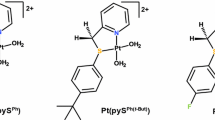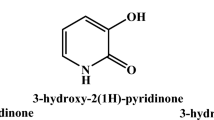Abstract
d(TpG)– reacts with cis-[Pt(NH3)2(H2O)2]2+ in two steps to yield the platinum chelate cis-[Pt(NH3)2{d(TpG)-N3(1),N7(2)}]. In the latter, hindered rotation of the bases leads to an equilibrium between two rotamers interconverting slowly on the NMR time scale. The structure of the two rotameric chelates was studied by means of 1H NMR and molecular modeling techniques. The major and minor rotamers could be assigned unambiguously to the two head-to-head conformational domains which are characterized by syn/anti and anti/anti sugar-base orientations, respectively. Molecular models derived for both rotamers show that the orientations of the bases are mutually quasi-enantiomeric. The interconversion between the two rotamers (k ≈ 1 s–1 at 293 K) is approximately 104 times faster than the analogous rotamer interconversion observed in cis-[Pt(NH3)2{r(CpG)-N3(1),N7(2)}]+ [Girault J-P, Chottard G, Lallemand J-Y, Huguenin F, Chottard J-C (1984) J Am Chem Soc 106 : 7227–7232], suggesting that the steric clash of the exocyclic amino group of the platinum-bound cytosine with the ligands in cis position is more severe than that of the two thymine oxo groups.
Similar content being viewed by others
Author information
Authors and Affiliations
Additional information
Received: 23 June 1997 / Accepted: 30 September 1997
Rights and permissions
About this article
Cite this article
Elizondo-Riojas, MA., Gonnet, F., Chottard, JC. et al. The TpG chelate of cis(diammineplatinum) forms two head-to-head rotamers in H2O solution . JBIC 3, 30–43 (1998). https://doi.org/10.1007/s007750050205
Issue Date:
DOI: https://doi.org/10.1007/s007750050205




